Tipping to Staying on the Ground: Internalized Knowledge of Climate Change Crucial for Transformed Air Travel Behavior
Abstract
1. Introduction
1.1. Climate Action and Air Travel
1.2. The Rising Fly-Less Movement in Sweden
1.3. Aims of This Study
2. Theoretical Framework
3. Materials and Methods
3.1. Recruitment of Interviewees
3.2. Data Collection and Analysis
4. Results
4.1. The Process of Reducing or Quitting Air Travel
4.1.1. Phase 1: Slow Variables Eroding Inertia
”The decision had been cooking for quite a while […] when I got more and more insights into the consequences I started to feel a bit bad when I did it […] The insights increase—the mental nausea increases.”Hans, quitter
4.1.2. Phase 2: Tipping Towards More Sustainable Habits
“The mask fell […] it became too embarrassing to continue to fly […]It felt paradoxical to have emitted such an amount of greenhouse gases […]when you are the kind of person who is engaged in these issues and should know better.So it was probably there that my climate conscience had enough”.Ida, quitter
“It stood out, it was like 90 percent of my emissions. So I felt that if I’m going to do something, I have to cut it out. So then I decided that now it’s enough.”Ola, quitter
4.1.3. Phase 3: Struggling and Learning to Overcome Barriers
“Somehow you want to go on travelling [by plane] but then you just have to decide that no, you won’t. And there is a period when breaking these habits that is a bit messy.”Frank, quitter
“I always feel like […] God, Olof, you are supposed to be an environmentalist! […] I hope my contribution will give a minus on some other carbon account.”Olof, reducer
4.1.4. Phase 4: Positive Feedbacks
“Now that I have done it for a year, really been fighting to get rid of as many flights as possible […] I have had time to travel a lot by train and noticed how much I like it.”Johannes, reducer
4.1.5. Phase 5: Developing New Priorities
”Another kind of thinking is needed. Maybe you should look where the happiness is? Is it really in Malta? Is it in Hurghada?”Jörgen, quitter
4.2. Incentives and Barriers to Air Travel Reduction
4.2.1. Emotional Internalization of Climate Change
“You can be horrified by the reports showing how bad it is and how soon we must change everything to save something. And on the other hand, life just rolls on. Like if these reports almost live in some parallel universe.”Annelie, non-reducer
“You can’t go around being depressed all the time […] then you wouldn’t be able to live. But it’s there, in the back of the head, all the time.”John, quitter
Since I got a child it became even more apparent. I almost panic thinking of how […] will she manage in the world if it goes on like this? Will she even have reasonable chances to get a good life? […] It’s causing incredibly much anxiety thinking of how little you can do yourself.”Stina, quitter
4.2.2. Political Versus Individual Responsibility
“If it’s a societal problem, it has to be regulated on a societal level. It can’t be up to ordinary people to decide this. So that’s a bit the reason, I guess, why I don’t [reduce].”
“I think it shouldn’t punish them […] As a kind of protest, I would continue to fly, if it’s the cheapest alternative, to show that it […] has to be regulated.”
“You can’t just shrug your shoulders and go on doing wrong. How can you live with yourself then? And then I think, if more people actually do something it will influence others.”Stina, quitter
4.2.3. Lack of Support from Society
“There is nothing else than a kind of stupid ‘I will do the right thing!’ And then you do the right thing, but you are just disadvantaged, because it takes more time, it’s more expensive and more hassle. There is no real benefit in acting like I do.”Frank, quitter
“There is no political will. We go on as long as we can, and then it goes to hell […] It’s a big frustration. Yes. And all I can do is to at least live somewhat decently. It’s not enough, I understand that, but I continue anyway.”Barbro, quitter
4.2.4. The value of flying
”If it hadn’t been one of the absolutely worst things I can do to […] the happiness in my life, I wouldn’t have waited so long.”Max, reducer
5. Discussion
6. Concluding Remarks
Supplementary Materials
Author Contributions
Funding
Acknowledgments
Conflicts of Interest
References
- UNFCCC. Paris Agreement; United Nations Framework Convention on Climate Change. Available online: https://unfccc.int/process-and-meetings/the-paris-agreement/the-paris-agreement/ (accessed on 27 May 2018).
- Masson-Delmotte, V.; Zhai, P.; Pörtner, H.O.; Roberts, D.; Skea, J.; Shukla, P.R.; Pirani, A.; Moufouma-Okia, W.; Péan, C.; Pidcock, R.; et al. Global warming of 1.5°C. An IPCC Special Report on the impacts of global warming of 1.5 °C above pre-industrial levels and related global greenhouse gas emission pathways, in the context of strengthening the global response to the threat of climate change, sustainable development, and efforts to eradicate poverty. Available online: https://ipcc.ch/sr15/ (accessed on 3 October 2019).
- Pörtner, H.-O.; Roberts, D.C.; Masson-Delmotte, V.; Zhai, P.; Tignor, M.; Poloczanska, E.; Mintenbeck, K.; Nicolai, M.; Okem, A.; Petzold, J.; et al. IPCC Special Report on the Ocean and Cryosphere in a Changing Climate. Available online: https://ipcc.ch/srocc/ (accessed on 3 October 2019).
- Anderson, K. Duality in climate science. Nat. Geosci. 2015, 8, 898. [Google Scholar] [CrossRef]
- Rockström, J.; Gaffney, O.; Rogelj, J.; Meinshausen, M.; Nakicenovic, N.; Schellnhuber, H.J. A Roadmap for Rapid Decarbonization. Science 2017, 355, 1269–1271. [Google Scholar] [CrossRef] [PubMed]
- Pelling, M.; O’Brien, K.; Matyas, D. Adaptation and transformation. Clim. Chang. 2015, 133, 113–127. [Google Scholar] [CrossRef]
- Göpel, M. The Great Mindshift: How a New Economic Paradigm and Sustainability Transformations go Hand in Hand; Wuppertal Institute Springer Open: Berlin/Heidelberg, Germany, 2016; ISBN 978-3-319-43766-8. [Google Scholar] [CrossRef]
- Fazey, I.; Moug, P.; Allen, S.; Beckmann, K.; Blackwood, D.; Bonaventura, M.; Burnett, K.; Danson, M.; Falconer, R.; Gagnon, A.S.; et al. Transformation in a changing climate: A research agenda. Clim. Dev. 2018, 10, 197–217. [Google Scholar] [CrossRef]
- O’Brien, K.; Sygna, L. Responding to Climate Change: The Three Spheres of Transformation. In Proceedings of the Transformation in a Changing Climate, 19–21 June 2013; University of Oslo: Oslo, Norway, 2013; pp. 16–23. ISBN 978-82-570-2000-2. [Google Scholar]
- Lee, D.S.; Fahey, D.W.; Forster, P.M.; Newton, P.J.; Wit, R.C.N.; Lim, L.L.; Owen, B.; Sausen, R. Aviation and global climate change in the 21st century. Atmos. Environ. 2009, 43, 3520–3537. [Google Scholar] [CrossRef]
- Azar, C.; Johansson, D.J.A. Valuing the non-CO2 climate impacts of aviation. Clim. Chang. 2012, 111, 559–579. [Google Scholar] [CrossRef]
- Kärcher, B. Formation and radiative forcing of contrail cirrus. Nat. Commun. 2018, 9, 1–17. [Google Scholar] [CrossRef]
- Gössling, S.; Peeters, P. ‘It Does Not Harm the Environment!’ An Analysis of Industry Discourses on Tourism, Air Travel and the Environment. J. Sustain. Tour. 2007, 15, 402–417. [Google Scholar] [CrossRef]
- Sullivan, A. To Fly or not to Fly? The Environmental Cost of Air Travel. Available online: https://www.dw.com/en/to-fly-or-not-to-fly-the-environmental-cost-of-air-travel/a-42090155 (accessed on 13 February 2020).
- Kamb, A.; Larsson, J.; Nässén, J.; Åkerman, J. Klimatpåverkan Från Svenska Befolkningens Internationella Flygresor; FTR-Rapport nr 2016:02; Chalmers Tekniska Högskola: Göteborg, Sweden, 2016. [Google Scholar]
- Åkerman, J. Climate impact of international travel by Swedish residents. J. Transp. Geogr. 2012. [Google Scholar] [CrossRef]
- Airbus. Global Market Forecast. Growing Horizons 2017–2036; Airbus: Blagnac, France, 2017. [Google Scholar]
- Peeters, P.; Higham, J.; Kutzner, D.; Cohen, S.; Gössling, S. Are technology myths stalling aviation climate policy? Transp. Res. Part D Transp. Environ. 2016, 44, 30–42. [Google Scholar] [CrossRef]
- Åkerman, J.; Larsson, J.; Elofsson, A. Svenska Handlingsalternativ För att Minska Flygets Klimatpåverkan; Kungliga Tekniska Högskolan: Stockholm, Sweden, 2016. [Google Scholar]
- Larsson, J. Hållbara Konsumtionsmönster. Analyser av Maten, Flyget Och Den Totala Konsumtionens Klimatpåverkan Idag Och 2050; Naturvårdsverket: Stockholm, Sweden, 2015. [Google Scholar]
- Wynes, S.; Nicholas, K.A. The climate mitigation gap: Education and government recommendations miss the most effective individual actions. Environ. Res. Lett. 2017, 12, 074024. [Google Scholar] [CrossRef]
- UNDP. Human Development Report 2007/2008 Fighting Climate Change: Human Solidarity in a Divided World; UNDP: New York, NY, USA, 2007; ISBN 9780230547049. [Google Scholar]
- Nykvist, B.; Persson, Å.; Moberg, F.; Persson, L.; Cornell, S.; Rockström, J. National Environmental Performance on Planetary Boundaries National Environmental; Naturvårdsverket: Stockholm, Sweden, 2013; ISBN 9789162065768. [Google Scholar]
- Neill, D.W.O.; Fanning, A.L.; Lamb, W.F.; Steinberger, J.K. A good life for all within planetary boundaries. Nat. Sustain. 2018, 1, 88. [Google Scholar] [CrossRef]
- Yakita, A.; Yamauchi, H. Environmental awareness and environmental R & D spillovers in differentiated duopoly. Res. Econ. 2011, 65, 137–143. [Google Scholar] [CrossRef]
- Hsu, C.C.; Lee, J.Y.; Wang, L.F.S. Consumers awareness and environmental policy in differentiated mixed oligopoly. Int. Rev. Econ. Financ. 2017, 51, 444–454. [Google Scholar] [CrossRef]
- Higham, J.; Reis, A.; Cohen, S.A. Australian climate concern and the ‘attitude–behaviour gap’. Curr. Issues Tour. 2016, 19, 338–354. [Google Scholar] [CrossRef]
- McDonald, S.; Oates, C.J.; Thyne, M.; Timmis, A.J.; Carlile, C. Flying in the face of environmental concern: Why green consumers continue to fly. J. Mark. Manag. 2015, 31, 1503–1528. [Google Scholar] [CrossRef]
- Cohen, S.A.; Higham, J.E.S. Eyes wide shut UK consumer perceptions on aviation climate impacts and travel decisions to New Zealand. Curr. Issues Tour. 2011, 14, 323–335. [Google Scholar] [CrossRef]
- Stern, P.C. New Environmental Theories: Toward a Coherent Theory of Environmentally Significant Behavior. J. Soc. Issues 2000, 56, 407–424. [Google Scholar] [CrossRef]
- Stern, P.C. Information, Incentives, and Proenvironmental Consumer Behavior. J. Consum. Policy 1999, 22, 461–478. [Google Scholar] [CrossRef]
- Moser, S.C.; Dilling, L. Communicating Climate Change: Closing the Science-Action Gap. In The Oxford Handbook of Climate Change and Society; Dryzek, J., Norgard, R.B., Schlosberg, D., Eds.; Oxford University Press: Oxford, UK, 2011; pp. 161–174. [Google Scholar]
- Kollmuss, A.; Agyeman, J. Mind the Gap: Why do people act environmentally and what are the barriers to pro-environmental behavior? Environ. Educ. Res. 2002, 8, 239–260. [Google Scholar] [CrossRef]
- Negev, M.; Sagy, G.; Garb, Y.; Salzberg, A.; Tal, A. Evaluating the environmental literacy of Israeli elementary and high school students. J. Environ. Educ. 2008, 39, 3–20. [Google Scholar] [CrossRef]
- Juvan, E.; Dolnicar, S. The attitude-behaviour gap in sustainable tourism. Ann. Tour. Res. 2014, 48, 76–95. [Google Scholar] [CrossRef]
- Gifford, R. The Dragons of Inaction: Psychological Barriers That Limit Climate Change Mitigation and Adaptation. Am. Psychol. 2011, 66, 290–302. [Google Scholar] [CrossRef] [PubMed]
- Weber, E.U. What shapes perceptions of climate change? New research since 2010. Wiley Interdiscip. Rev. Clim. Chang. 2016, 7, 125–134. [Google Scholar] [CrossRef]
- Stoknes, P.E. What We Think about When We Try not to Think about Global Warming: Toward a New Psychology of Climate Action; Chelsea Green Publishing: White River Junction, VT, USA, 2015. [Google Scholar]
- Norgaard, K.M. Living in Denial: Climate Change, Emotions, and Everyday Life; MIT Press: Cambridge, MA, USA, 2011. [Google Scholar]
- Shove, E. Beyond the ABC: Climate change policy and theories of social change. Environ. Plan. A 2010, 42, 1273–1285. [Google Scholar] [CrossRef]
- Cohen, S.A.; Higham, J.E.S.; Reis, A.C. Sociological barriers to developing sustainable discretionary air travel behaviour. J. Sustain. Tour. 2013, 21, 982–998. [Google Scholar] [CrossRef]
- Büchs, M. The role of values for voluntary reductions of holiday air travel. J. Sustain. Tour. 2016, 25, 234–250. [Google Scholar] [CrossRef]
- Kroesen, M. Exploring people’s viewpoints on air travel and climate change: understanding inconsistencies. J. Sustain. Tour. 2013, 21, 271–290. [Google Scholar] [CrossRef]
- Climate Change and Aviation: Issues, Challenges and Solutions; Gössling, S., Upham, P., Eds.; Earthscan: London, UK, 2009. [Google Scholar]
- Cohen, S.A.; Higham, J.E.S.; Cavaliere, C.T. Binge flying. Behavioural addiction and climate change. Ann. Tour. Res. 2011, 25, 234–250. [Google Scholar] [CrossRef]
- Randles, S.; Mander, S. Practice(s) and ratchet(s): A sociological examination of frequent flying. In Climate Change and Aviation: Issues, Challenges and Solutions; Gössling, S., Upham, P., Eds.; Earthscan: London, UK, 2009; pp. 245–271. [Google Scholar]
- Naturvårdsverket. Växthusgaser—konsumtionsbaserade utsläpp per person. Available online: https://www.naturvardsverket.se/Sa-mar-miljon/Statistik-A-O/Vaxthusgaser-konsumtionsbaserade-utslapp-per-person/ (accessed on 16 February 2020).
- Lee, T.M.; Markowitz, E.M.; Howe, P.D.; Ko, C.-Y.; Leiserowitz, A.A. Predictors of public climate change awareness and risk perception around the world. Nat. Clim. Chang. 2015. [Google Scholar] [CrossRef]
- Gössling, S.; Haglund, L.; Kallgren, H.; Revahl, M.; Hultman, J. Swedish air travellers and voluntary carbon offsets towards the co creation of environmental value. Curr. Issues Tour. 2009, 12, 1–19. [Google Scholar] [CrossRef]
- Martinsson, J.; Andersson, U. Svenska Trender 1986–2017; Martinsson, J., Andersson, U., Eds.; SOM Institute: Göteborg, Sweden, 2018. [Google Scholar]
- Kamb, A.; Larsson, J. Klimatpåverkan från svenska befolkningens flygresor 1990–2017. Available online: https://research.chalmers.se/en/publication/506796 (accessed on 15 February 2020).
- Larsson, J.; Kamb, A.; Nässén, J.; Åkerman, J. Measuring greenhouse gas emissions from international air travel of a country’s residents methodological development and application for Sweden. Environ. Impact Assess. Rev. 2018, 72, 137–144. [Google Scholar] [CrossRef]
- Liljestrand, J. Jag är trött på att visa mina barn en döende värld. Available online: https://www.expressen.se/kultur/jens-liljestrand/jag-ar-trott-pa-att-visa-mitt-barn-en-doende-varld/ (accessed on 14 January 2018).
- Mjörnstedt Karlsten, J. Hur kunde jag inte veta detta. Available online: https://www.expressen.se/gt/kronikorer/julia-mjornstedt-karlsten/hur-kunde-jag-inte-veta-detta/ (accessed on 15 January 2018).
- Hadley Kamptz, I. Jag ser deras flygresor och min avund vet inga gränser. Available online: https://www.expressen.se/kultur/isobel-hadley-kamptz/jag-ser-deras-resor-och-min-avund-vet-inga-granser/ (accessed on 17 January 2018).
- Wolrath-Söderberg, M.; Wormbs, N. Grounded—Beyond Flygskam; Fores: Stockholm, Sweden, 2019. [Google Scholar]
- Mkono, M. Eco-anxiety and the flight shaming movement: Implications for tourism. J. Tour. Fut. 2019, 3. [Google Scholar] [CrossRef]
- Transportstyrelsen. Available online: https://www.transportstyrelsen.se/sv/Nyhetsarkiv/flygresandet-minskade-kraftigt-under-arets-forsta-kvartal/ (accessed on 14 April 2019).
- Barr, S.; Prillwitz, J. A Smarter Choice? Exploring the Behaviour Change Agenda for Environmentally Sustainable Mobility. Environ. Plan. C Gov. Policy 2014, 32, 1–19. [Google Scholar] [CrossRef]
- Feola, G. Societal transformation in response to global environmental change: A review of emerging concepts. Ambio 2015, 44, 376–390. [Google Scholar] [CrossRef]
- O’Brien, K. Political agency: The key to tackling climate change. Science 2015, 350, 1170–1171. [Google Scholar] [CrossRef]
- O’Brien, K. Is the 1.5°C target possible? Exploring the three spheres of transformation. Curr. Opin. Environ. Sustain. 2018, 31, 153–160. [Google Scholar] [CrossRef]
- Otto, I.M.; Donges, J.F.; Cremades, R.; Bhowmik, A.; Hewitt, R.J.; Lucht, W.; Rockström, J.; Allerberger, F.; McCaffrey, M.; Doe, S.S.P.; et al. Social tipping dynamics for stabilizing Earth’s climate by 2050. Proc. Natl. Acad. Sci. USA 2020. [Google Scholar] [CrossRef]
- Milkoreit, M.; Hodbod, J.; Baggio, J.; Benessaiah, K.; Donges, J.F.; Mathias, J.; Rocha, J.C.; Schoon, M. Defining tipping points for social-ecological systems scholarship—An interdisciplinary literature review. Environ. Res. Lett. 2018, 13, 033005. [Google Scholar] [CrossRef]
- Kvale, S.; Brinkmann, S. Den Kvalitativa Forskningsintervjun, 3rd ed.; Studentlitteratur: Lund, Sweden, 2014. [Google Scholar]
- Bryman, A. Social Research Methods; Oxford University Press: Oxford, UK, 2012. [Google Scholar]
- Tågsemester. Available online: https://www.facebook.com/groups/tagsemester/ (accessed on 1 October 2017).
- Jag flyger inte—för klimatets skull. Available online: www.facebook.com/groups/flygerinte/ (accessed on 29 September 2017).
- Vi som gillar att resa. Available online: www.facebook.com/groups/Visomgillarattresa/ (accessed on 2 October 2017).
- Teddlie, C.; Tashakkori, A. Foundations of Mixed Methods Research: Integrating Quantitative and Qualitative Approaches in the Social and Behavioral Sciences; SAGE Publishing: Thousand Oaks, CA, USA, 2009. [Google Scholar]
- Braun, V.; Clarke, V. Using thematic analysis in psychology. Qual. Res. Psychol. 2006, 3, 77–101. [Google Scholar] [CrossRef]
- Boyatzis, R.E. Transforming Qualitative Information: Thematic Analysis and Code Development; SAGE Publishing: Thousand Oaks, CA, USA, 1998. [Google Scholar]
- Bennett, E.M.; Solan, M.; Biggs, R.; McPhearson, T.; Norström, A.V.; Olsson, P.; Pereira, L.; Peterson, G.D.; Raudsepp-Hearne, C.; Biermann, F.; et al. Bright spots: Seeds of a good Anthropocene. Front. Ecol. Environ. 2016, 14, 441–448. [Google Scholar] [CrossRef]
- Ojala, M. Hope in the Face of Climate Change: Associations with Environmental Engagement and Student Perceptions of Teachers Emotion Communication Style and Future Orientation. J. Environ. Educ. 2015. [Google Scholar] [CrossRef]
- Plutzer, E.; Mccaffrey, M.; Hannah, A.L.; Rosenau, J.; Berbeco, M.; Reid, A.H. Climate confusion among U.S. teachers. Science 2016, 351, 664–665. [Google Scholar] [CrossRef] [PubMed]
- Roberts, D. Social Tipping Points are the Only Hope for the Climate. Available online: https://www.vox.com/energy-and-environment/2020/1/29/21083250/climate-change-social-tipping-points (accessed on 8 February 2020).
- Soper, K. Alternative Hedonism, culture theoty and the role of aesthetic revisioning. Cult. Stud. 2008, 22, 567–587. [Google Scholar] [CrossRef]
- Antadze, N.; McGowan, K.A. Moral entrepreneurship: Thinking and acting at the landscape level to foster sustainability transitions. Environ. Innov. Soc. Transit. 2017, 25, 1–13. [Google Scholar] [CrossRef]
- Coffey, H. What is “flygskam”? Everything you need to know about the environmental movement that’s sweeping Europe. Available online: https://www.independent.co.uk/travel/news-and-advice/flygskam-anti-flying-flight-shaming-sweden-greta-thornberg-environment-air-travel-train-brag-a8945196.html (accessed on 8 February 2020).
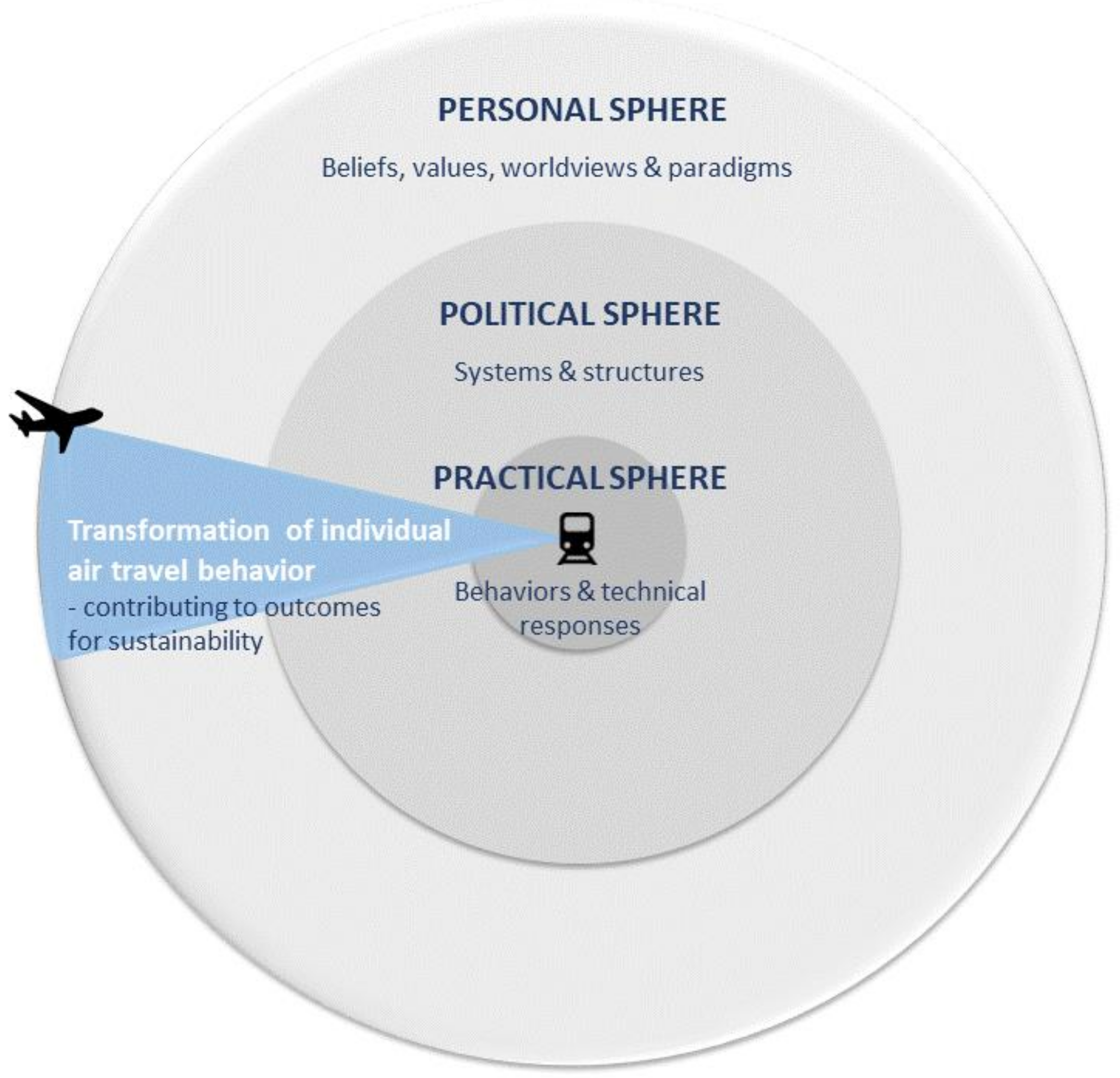
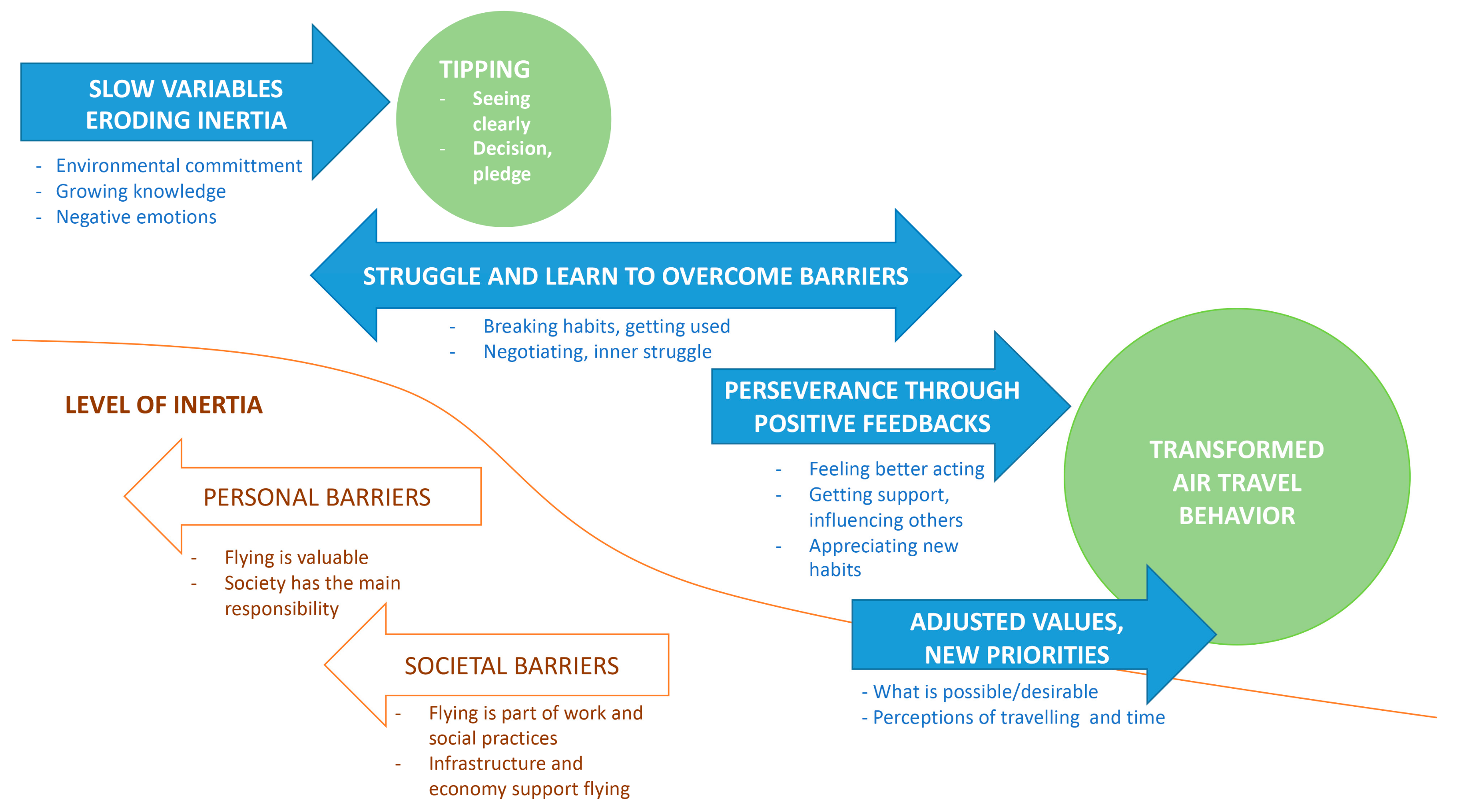
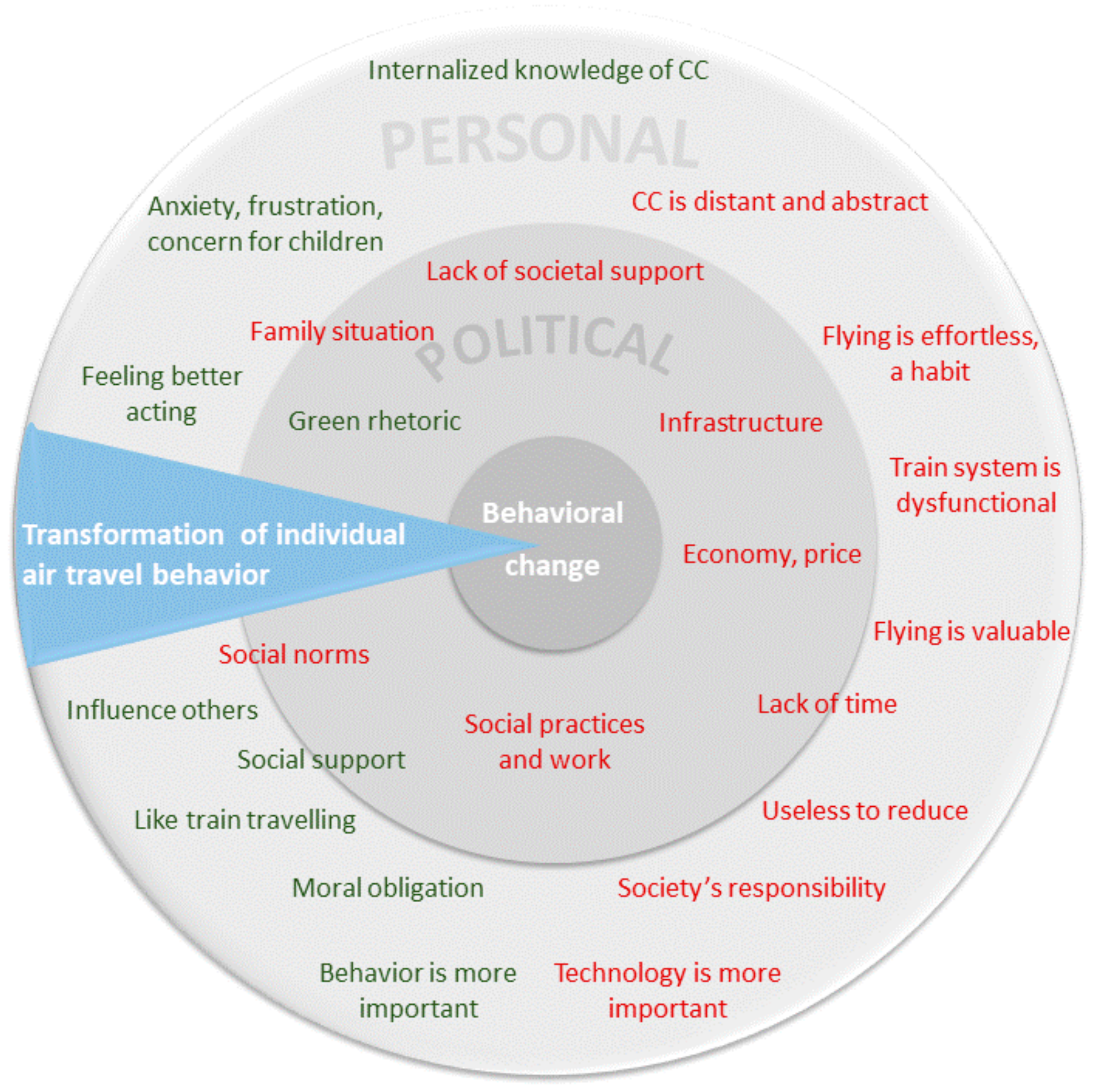
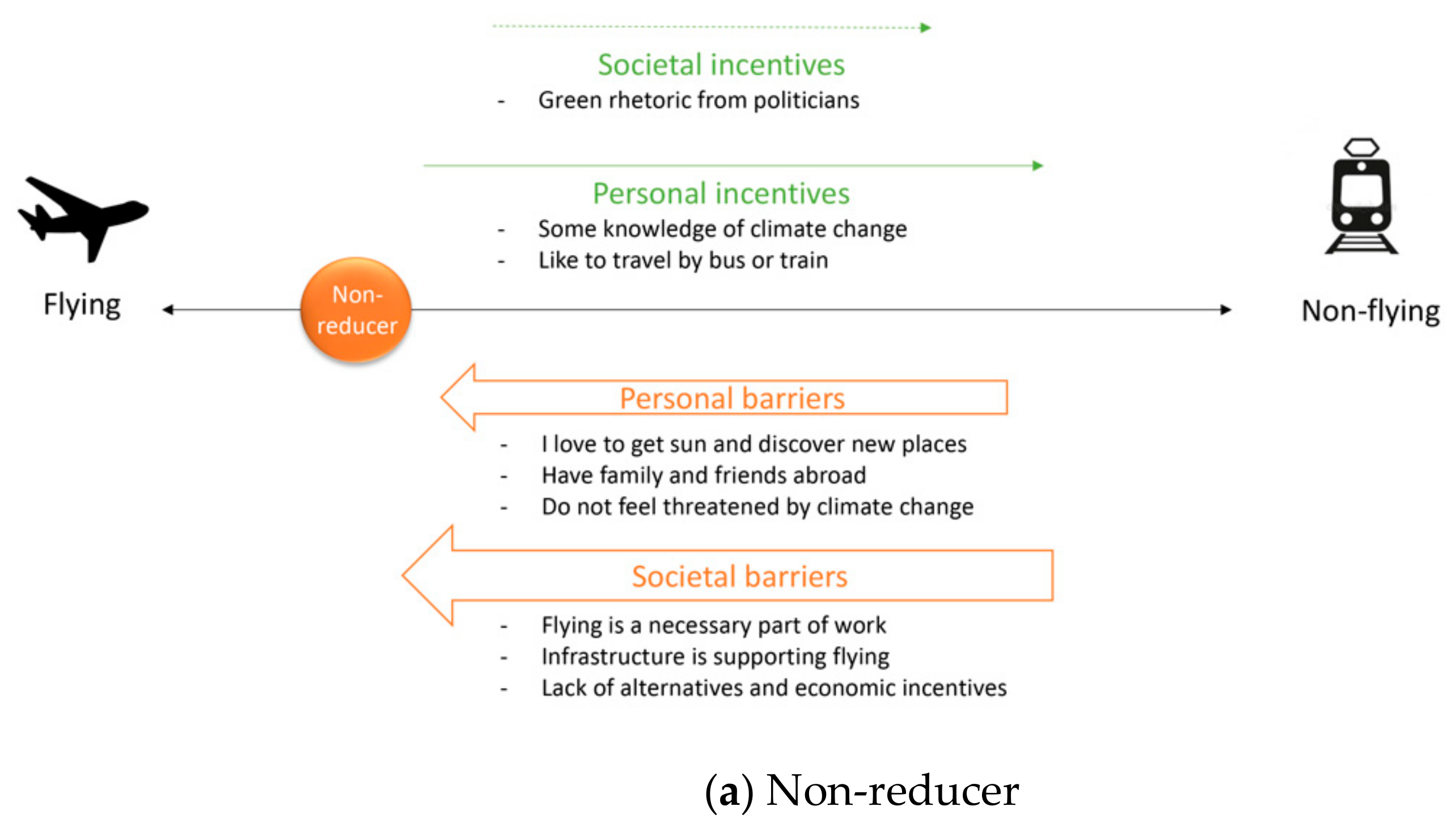
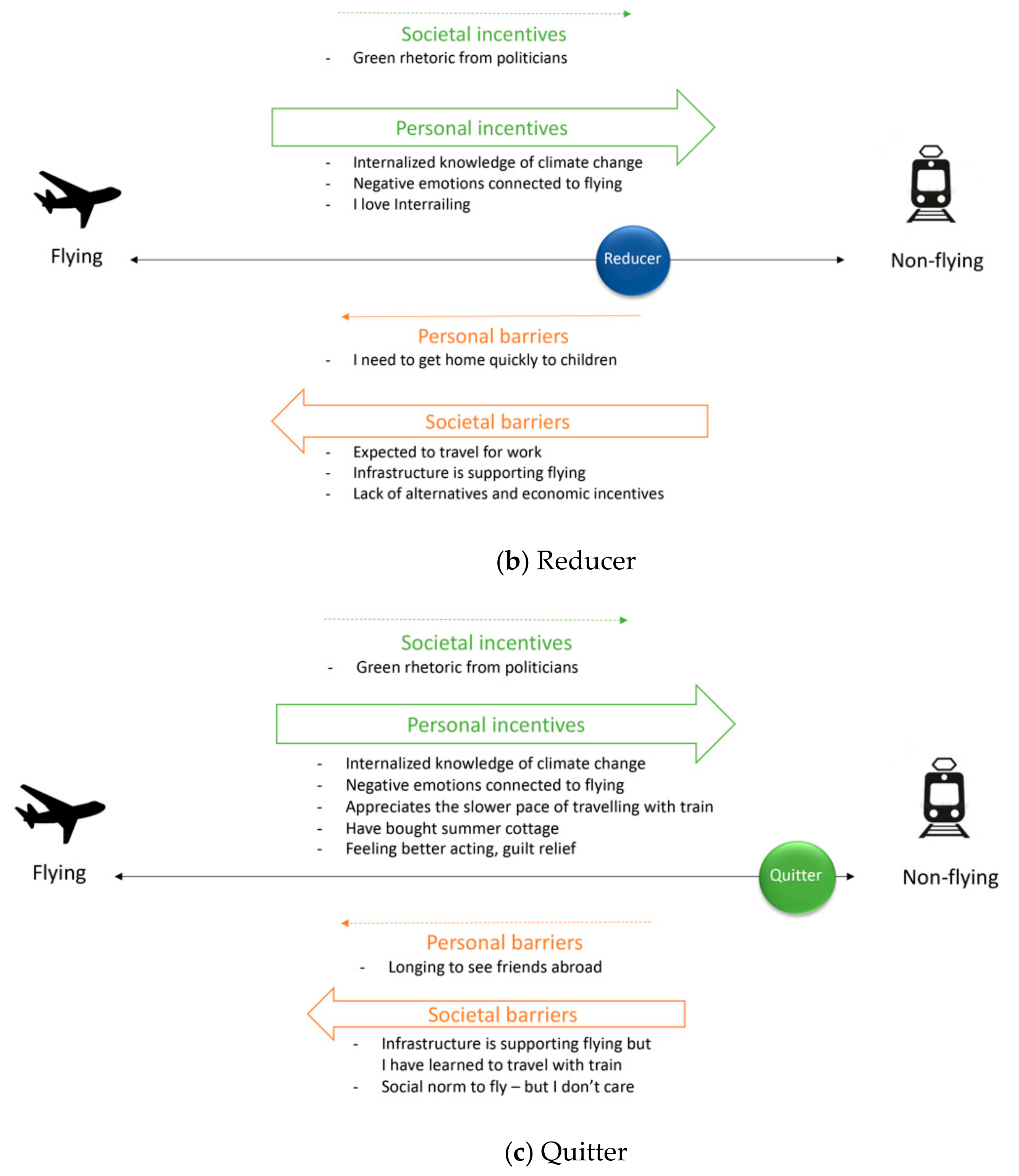
| Pseudonym | Age | Gender | Place of Residence | Occupation | Category |
|---|---|---|---|---|---|
| Ida | 28 | F | Town, South Sweden | Student | Quitter |
| Stina | 38 | F | Stockholm | Social worker | Quitter |
| Jörgen | 50 | M | Town, middle Sweden | Tractor driver | Quitter |
| Frank | 36 | M | Village, middle Sweden | Forester | Quitter |
| Hans | 61 | M | Town, West Sweden | Sustainability consultant | Quitter |
| Kerstin | 61 | F | Town, middle Sweden | Healthcare officer (on sick leave) | Quitter |
| David | 47 | M | Stockholm | Communications officer | Quitter |
| John | 44 | M | Village, South Sweden | Musician | Quitter |
| Barbro | 68 | F | Town, West Sweden | Retired researcher | Quitter |
| Jakob | 52 | M | Town, middle Sweden | City planner | Quitter |
| Olof | 30 | M | Town, West Sweden | Political officer/politician | Reducer |
| Johannes | 30 | M | Town, South Sweden | University official | Reducer |
| Julia | 41 | F | Stockholm | Energy consultant (self-employed) | Reducer |
| Lotta | 32 | F | Village, West Sweden | Social worker (on parental leave) | Reducer |
| Sara | 45 | F | Town, North Sweden | Project manager, engineer | Reducer |
| Sixten | 41 | M | Stockholm | IT consultant | Reducer |
| Max | 30 | M | Town, South Sweden | Web developer | Reducer |
| Kristian | 44 | M | Stockholm | Media consultant (self-employed) | Reducer |
| Malin | 55 | F | Town, West Sweden | Journalist (self-employed) | Reducer |
| Diana | 41 | F | Stockholm | Teacher | Non-reducer |
| Jan-Erik | 72 | M | Stockholm | Retired financial manager | Non-reducer |
| Annelie | 42 | F | Stockholm | Journalist, manager | Non-reducer |
| Henrik | 42 | M | Stockholm | Purchaser of IT systems | Non-reducer |
| Staffan | 32 | M | Stockholm | Researcher | Non-reducer |
| Siv | 66 | F | Village, middle Sweden | Retired occupational therapist | Non-reducer |
| Niklas | 35 | M | Town, North Sweden | Pedagogue | Non-reducer |
 Quitter: Have made a decision not to fly, or once every five years at the most, and this is reflected by few flights 2015–2017);
Quitter: Have made a decision not to fly, or once every five years at the most, and this is reflected by few flights 2015–2017);  Reducer: Have made a decision to reduce air travelling and self-report to have reduced to various degrees, compared to the previous five years;
Reducer: Have made a decision to reduce air travelling and self-report to have reduced to various degrees, compared to the previous five years;  Non-reducer: Self-report to fly approximately as much as the previous five years).
Non-reducer: Self-report to fly approximately as much as the previous five years).© 2020 by the authors. Licensee MDPI, Basel, Switzerland. This article is an open access article distributed under the terms and conditions of the Creative Commons Attribution (CC BY) license (http://creativecommons.org/licenses/by/4.0/).
Share and Cite
Jacobson, L.; Åkerman, J.; Giusti, M.; Bhowmik, A.K. Tipping to Staying on the Ground: Internalized Knowledge of Climate Change Crucial for Transformed Air Travel Behavior. Sustainability 2020, 12, 1994. https://doi.org/10.3390/su12051994
Jacobson L, Åkerman J, Giusti M, Bhowmik AK. Tipping to Staying on the Ground: Internalized Knowledge of Climate Change Crucial for Transformed Air Travel Behavior. Sustainability. 2020; 12(5):1994. https://doi.org/10.3390/su12051994
Chicago/Turabian StyleJacobson, Lisa, Jonas Åkerman, Matteo Giusti, and Avit K. Bhowmik. 2020. "Tipping to Staying on the Ground: Internalized Knowledge of Climate Change Crucial for Transformed Air Travel Behavior" Sustainability 12, no. 5: 1994. https://doi.org/10.3390/su12051994
APA StyleJacobson, L., Åkerman, J., Giusti, M., & Bhowmik, A. K. (2020). Tipping to Staying on the Ground: Internalized Knowledge of Climate Change Crucial for Transformed Air Travel Behavior. Sustainability, 12(5), 1994. https://doi.org/10.3390/su12051994






